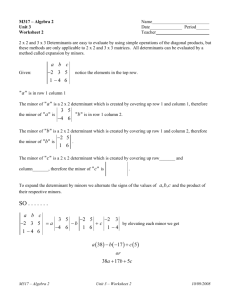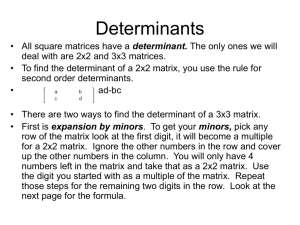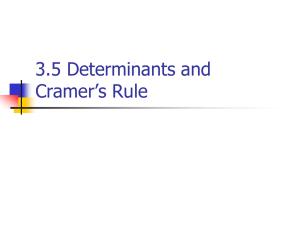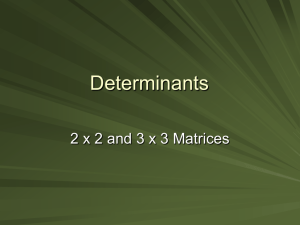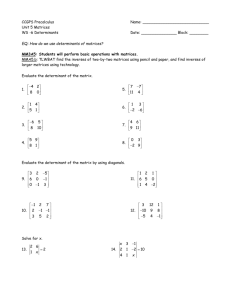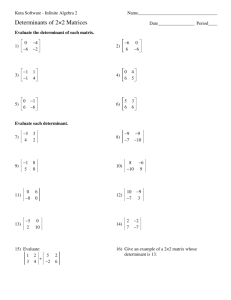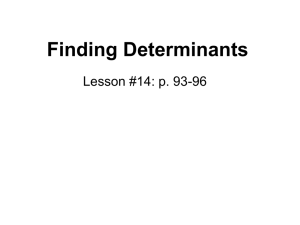4.5 Determinants
advertisement
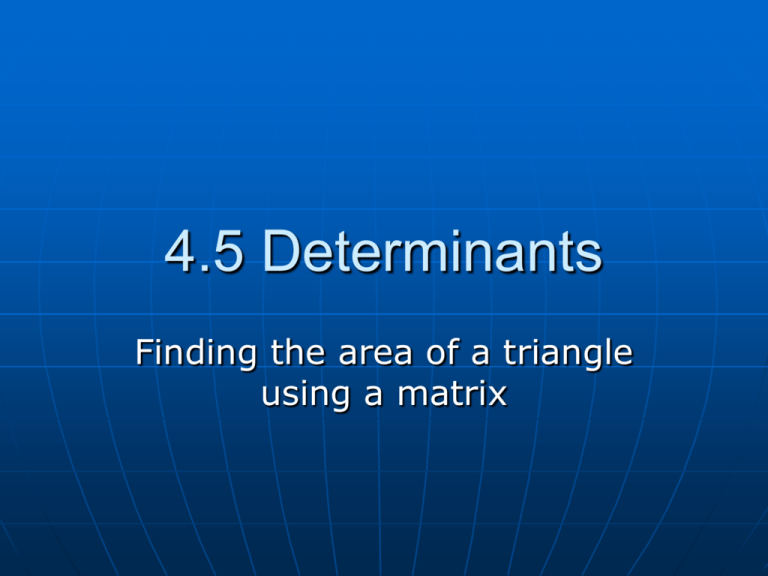
4.5 Determinants Finding the area of a triangle using a matrix A Determinants is a number The matrix must be square, meaning its dimension can be a 2 X 2, 3 X 3, 4 X 4 and so on. The determinants is used to solve system of equations or find the area of a triangle. Lets find the determinant of a 2 X 2 Let 2 3 A 5 8 The determinant of A is written as | A | 2 3 5 8 How to find the Determinant Multiply the top left and bottom right, then subtract it from the multiplication of the top right and the bottom left. | A | 2 3 5 8 2 *8 5*3 | A | = 16 – 15 = 1 Find the Determinant 6 7 B 10 12 Find the Determinant 6 7 B 10 12 (-7 * - 12) – (6 * 10) = Find the Determinant 6 7 B 10 12 (-7 * - 12) – (6 * 10) = 84 – 60 = 24 What about a 3 X 3 One method is expansion by minors. 1 0 1 2 1 3 4 2 3 1 0 1 2 1 3 4 2 3 The top row are the minors. 1, 0, -1 1 3 1 The minor of 1 is 2 3 You cut out the numbers in the row and column the minor is in What about a 3 X 3 1 0 1 2 1 3 The minor of 1 is 1 4 2 3 1 0 1 2 1 3 4 2 3 1 0 1 2 1 3 4 2 3 The minor of 0 is 0 1 3 2 3 2 3 4 3 The minor of - 1 is 1 2 1 4 2 Using the minor to find the determinant Since we are using the top row. We subtract the second minor from the first the add the last minor. + 1 1 3 2 3 - 0 2 3 4 3 + 1 2 1 4 2 Using the minor to find the determinant Since we are using the top row. We subtract the second minor from the first the add the last minor. + 1 1 3 2 3 - 0 2 3 4 3 + 1 2 1 4 2 Find the determinants of the 2 X 2 Using the minor to find the determinant Since we are using the top row. We subtract the second minor from the first the add the last minor. + 1 1 3 2 3 2 3 - 04 3 + 1 2 1 4 2 1((-1*-3)-(3*-2)) – 0((2*- 3)-(3*4)) + (-1)((2*-2)-(-1 * 4)) 1(3 – (-6)) – 0(-6 – 12) + (-1)(-4 – (-4)) 1(9) -0(- 18) + (-1)(0) = 9 – 0 + 0 = 9 Using the minor to find the determinant Since we are using the top row. We subtract the second minor from the first the add the last minor. + 1 1 3 2 3 2 3 - 04 3 + 1 2 1 4 2 1((-1*-3)-(3*-2)) – 0((2*- 3)-(3*4)) + (-1)((2*-2)-(-1 * 4)) 1(3 – (-6)) – 0(-6 – 12) + (-1)(-4 – (-4)) 1(9) -0(- 18) + (-1)(0) = 9 – 0 + 0 = 9 Using the minor to find the determinant Since we are using the top row. We subtract the second minor from the first the add the last minor. + 1 1 3 2 3 2 3 - 04 3 + 1 2 1 4 2 1((-1*-3)-(3*-2)) – 0((2*- 3)-(3*4)) + (-1)((2*-2)-(-1 * 4)) 1(3 – (-6)) – 0(-6 – 12) + (-1)(-4 – (-4)) 1(9) -0(- 18) + (-1)(0) = 9 – 0 + 0 = 9 Lets look at that with just variables a b c d f a e g h So i e f h i b d f g i c d e g h a(ei hf ) b(di gf ) c(dh eg ) Another way Take the matrix's last two columns and place them outside the matrix. a b c d e f g h i a b c a b becomes d e f d e g h i g h We are going to multiply down at an angle, one way then the other way Multiply at from top to bottom left to right, then add. Repeat going from right to left then add. To finish subtract the first multiplied sum from the last. a b c a b d e f d e g h i g h ( a * e * i b * f * g c * d * h ) (c * e * g a * f * h b * d * i ) Lets use this method A 1 0 1 1 2 1 3 0 2 1 4 2 3 4 2 (1* -1 * -3 + 0 * 3 * 4 + -1 * 2 * - 2) – (-1* -1 * 4 + 1* 3 * - 2 + 0 * 2 * -3) (3 + 0 + 4) – (4 - 6 + 0) = 7 – ( - 2) = 9 To find the area of a triangle Find the vertices of the triangle. Place them in (0,4) a 3 X 3 matrix Making the last column 4 0 1 (4,0) All 1’s 0 2 4 1 2 1 (2,2) Find the determinants 4 0 1 0 4 1 2 2 1 -4(4 - (-2)) - 0(0 - 2) + 1(0 - 8) = -32 Then multiply + ½ or - ½ whatever makes it a positive number. - ½ * -32 = 16 With variables: Area of a Triangle With points (A,B) , (C, D) and (E,F) Homework Page 186 – 187 # 15 – 37 odd, 43 Homework Page 186 – 187 # 16 – 38 even, 44

